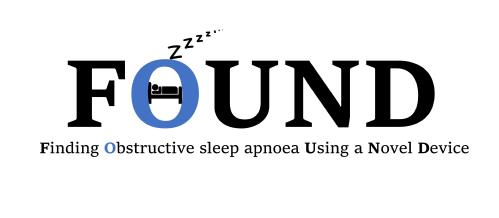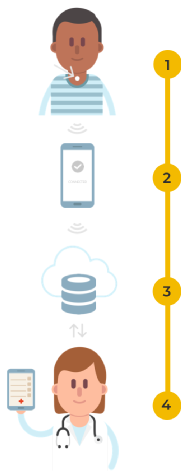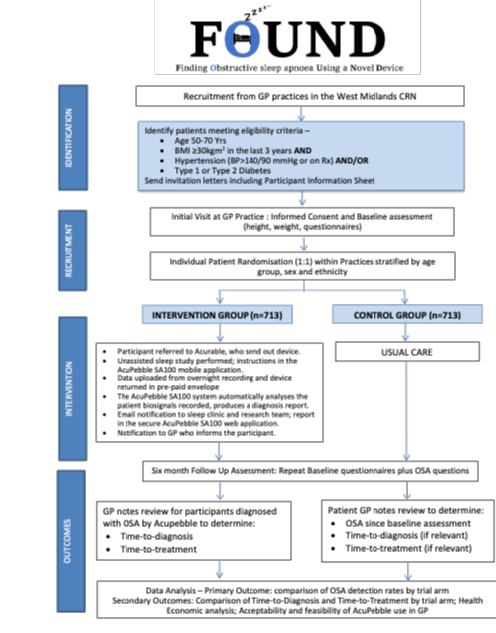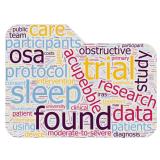FOUND Trial

ISRCTN 16982033
Summary
Obstructive Sleep Apnoea (OSA) is a sleep problem which causes the airway to become slightly or completely blocked during sleep. The brain, detecting low blood oxygen levels, sends signals that cause the person to wake up, restoring normal breathing. OSA increases the risk of dying from heart disease and stroke. It often causes daytime sleepiness and increases risk of road traffic accidents. Awareness levels of OSA in the UK are low. It is estimated that up to 85% of people with OSA remain undiagnosed and untreated. Currently, a patient with symptoms that indicate OSA needs a GP referral to specialist hospital services to attend hospital, collect and be instructed on how to use the overnight sleep study equipment, return it next day and wait for data analysis and hospital follow-up appointment. Pre-pandemic, waiting time for referral to a sleep clinic in Coventry was over 4 months.
 The AcuPebble SA100, the first medical device to obtain official product approval for the automated diagnosis of OSA, can be posted to a patient; with results immediately calculated and sent to the hospital Sleep Specialist. The British Lung Foundation estimated the annual savings to the NHS in the UK would be £28 million, if all people with moderate to severe OSA were diagnosed and treated.
The AcuPebble SA100, the first medical device to obtain official product approval for the automated diagnosis of OSA, can be posted to a patient; with results immediately calculated and sent to the hospital Sleep Specialist. The British Lung Foundation estimated the annual savings to the NHS in the UK would be £28 million, if all people with moderate to severe OSA were diagnosed and treated.
Our research aims to find out if the AcuPebble can be used in a General Practice for OSA diagnosis. We will invite patients who may be at higher risk of OSA (overweight, have hypertension, diabetes or both) to take part in the study and split into two groups. One group (intervention) will complete a home overnight sleep study using the AcuPebble. The other (control) group will continue as normal (referred to hospital via the traditional pathway if presenting a sleep study need). Individuals diagnosed with OSA in either group will be referred for treatment through existing care pathways.
We will compare the number of new diagnoses of OSA in the two groups, looking at how well this new approach works compared to the current hospital-based referral route, and whether it is value for money for the NHS. If this strategy is successful in detecting OSA, it can be rolled out in primary care to improve the detection and treatment of OSA. Better detection would reduce risks, improve health and wellbeing; with fewer longer term health conditions.
Acurable representatives (AcuPebble's supplier), the Sleep Apnoea Trust and Hope2Sleep support the project. The latter’s founder, a patient with OSA, has been involved in the development of the project. They will join the project management group. Findings would be shared with patients and the public in research papers, conference presentations, public engagement events, social media and through relevant charities.
Scientific abstract
AIMS. To determine (a) feasibility of testing for obstructive sleep apnoea (OSA) into GP using AcuPebble, (b) if case finding in GP increases detection rate of OSA (c) if GP-based screening is cost-effective.
OBJECTIVES. To determine if the use of AcuPebble increases detection of OSA in high-risk groups; cost effectiveness versus standard practice in people at high-risk; to compare hospital-based referral route with GP based route.
DESIGN. Randomised controlled trial of case-finding of OSA in primary care using a novel MHRA-registered device (AcuPebble SA100) compared to usual care, with internal feasibility phase to assess fidelity of delivery of the device, acceptability to patients and primary care team. After eligibility screening, consent and baseline assessment, participants randomised to either an Intervention or a Control group for 6 months.
RECRUITMENT. Forty GPs from the West Midlands CRN. They will identify eligible patients meeting the inclusion criteria.
INCLUSION CRITERIA. Age 50-70 years with BMI > 30 Kg/m2 and/or diabetes (type 1 or 2) and/or hypertension (office BP >145/90 mmHg or on treatment) as of GP records.
EXCLUSION CRITERIA. Patients with known OSA, those deemed unable to take part by their GP, (e.g. terminally ill), patients with known allergy to acrylate.

INTERVENTION. Participants will receive by post the overnight sleep testing device. No hospital attendance is required, and its use does not require training. The test is comfortable, non-invasive, using a small device attached to the throat, without being attached to leads or wires.
CONTROL. Participants will continue with usual care.
POPULATION. 1,426 eligible participants randomised 1:1 to Intervention or Control group. Due to the nature of the intervention, participants and GPs will not be blinded to the allocation. However, the assessment of primary outcomes will be automated.
OUTCOMES. Primary: Intervention OSA detection rate versus control detection rate. Secondary: Time-to-diagnosis and time-to-treatment for new pathway (intervention group) v control group; Cost-effectiveness analysis comparing new vs current pathways; Feasibility and acceptability of new sleep study testing.
ASSESSMENTS. Proportion of participants with a diagnosis of OSA.
SAMPLE SIZE. Detection of new cases of OSA using usual care is <5% per year. Given the observed rates of hypertension, obesity, diabetes mellitus in individuals with OSA, we expect a detection rate of => 10% in the Intervention group. The study is powered (90%) to detect a 5% difference and will require 606 patients in each arm. To allow 15% attrition and lost to follow up, 713 in each arm are need.
FEASIBILITY. An internal feasibility phase will assess fidelity of delivery of the device, acceptability to patients and primary care teams. We will review recruitment, data collection, AcuPebble study, allowing modifications to trial before recruitment starts at month 9.
ANALYSIS. Primary analysis: new cases of OSA diagnosed in Intervention compared to Control group. Secondary analyses: time-to-diagnosis and time-to-treatment for new pathway (intervention group) v control group, cost-effectiveness analysis (new vs current pathway), feasibility and acceptability of sleep study testing.
Investigators
Joint CIs
Prof MA Miller (U of Warwick)
Prof FP Cappuccio (U of Warwick)
Co-PIs
Dr A Ali (UHCW NHS)
Dr P Apenteng (U of Birmingham)
Dr P Auguste (U of Warwick)
Prof J Dale (U of Warwick)
Mrs K Hope (Hope2Sleep)
Prof L-M Yu (U of Oxford)
Collaborators
Prof A Grove (U of Warwick)
Dr S Prakash (U of Warwick)
Mr C Rogers (Sleep Apnoea Trust)
Contractors/Suppliers
Ms O Dessi (Acurable)
Prof E Rodriguez-Villegas (Imperial College London)
Mr E Sanz-Pereiras (Acurable)
Researchers
University of Warwick
Dr E Scott (Project Manager)
Dr R Harrison (CT Facilitator)
Ms E Buckingham (CT Facilitator)
University of Oxford CTU
Mr J Burbage (QA Manager)
Mr L Costello (IT/Database Manager)
Ms J Grabey (Data Manager)
Mr O Llion (Trial Coordinator)
Ms J Rahman (Sn Trial Manager, 1/4/23-)
Ms M Shanyinde (Statistician)
Ms A Smith (Trial Manager)
Dr N Tran (Sn Trial Manager, 1/11/22-31/3/23)
Funding

Duration
30 months
Contacts
FOUND Trial
University of Warwick
Warwick Medical School
Gibbet Hill Road
Coventry, CV4 7AL
Tel: +44 (0)2476 574654
e-mail: FOUND@warwick.ac.uk
see also University of Oxford website
e-mail: found@phc.ox.ac.uk
Resources
A pilot study of a wearable apnoea detection device. BMJ Open 2014
Accuracy and usability of AcuPebble SA100 for automated diagnosis of obstructive sleep apnoea in the home environment setting: an evaluation study. BMJ Open 2021

